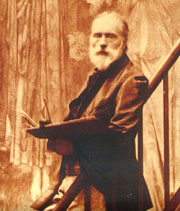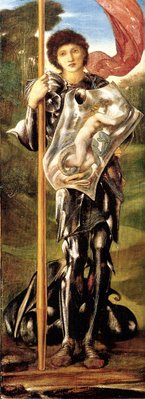 Edward Burne-Jones (1883-1898) was an English Pre-Raphaelite painter. Although he tapped into the wells of Pre-Raphaelite subject matter, he was more concerned with decorative beauty than narrative content. In this view, he is often associated with the Aesthetic Movement, which stressed that beauty should exist for its own sake, and should be available to all people, not just the elite.
Edward Burne-Jones (1883-1898) was an English Pre-Raphaelite painter. Although he tapped into the wells of Pre-Raphaelite subject matter, he was more concerned with decorative beauty than narrative content. In this view, he is often associated with the Aesthetic Movement, which stressed that beauty should exist for its own sake, and should be available to all people, not just the elite. Saint George (1877). St. George, having been adopted by England as its patron saint (though he was a Roman and battled his famous dragon opponent in Libya), was a major source of Pre-Raphaelite content. St. George's armor glistens in the sunlight and his shield reflects a clear image of the virgin princess that he seeks to rescue.
Saint George (1877). St. George, having been adopted by England as its patron saint (though he was a Roman and battled his famous dragon opponent in Libya), was a major source of Pre-Raphaelite content. St. George's armor glistens in the sunlight and his shield reflects a clear image of the virgin princess that he seeks to rescue.More than his companions, Burne-Jones was able to drop the post-Raphael figurative norms. Compare.
 Perseus and the Sea Nymphs (1877). Burne-Jones composed a series of works depicting the Perseus narrative. A true Aesthete, Burne-Jones makes no attempt to depict the characters realistically, as seen in their dirt-free soles. Extolling their refinement, the artist has posed the nymphs to reflect the Three Graces.
Perseus and the Sea Nymphs (1877). Burne-Jones composed a series of works depicting the Perseus narrative. A true Aesthete, Burne-Jones makes no attempt to depict the characters realistically, as seen in their dirt-free soles. Extolling their refinement, the artist has posed the nymphs to reflect the Three Graces. The Bride of Lebanon (1891) is one of Burne-Jones' watercolors. He drew deep from the well of Biblical content, taking from the Song of Solomon in this piece:
The Bride of Lebanon (1891) is one of Burne-Jones' watercolors. He drew deep from the well of Biblical content, taking from the Song of Solomon in this piece:You are altogether beautiful, my darling,
And there is no blemish in you.
"Come with me from Lebanon, my bride,
May you come with me from Lebanon
Journey down from the summit of Amana,
From the summit of Senir and Hermon,
From the dens of lions,
From the mountains of leopards.

3 comments:
John I really enjoy your art blogging posts.
Please never stop posting the art! Although it may not generate as many comments back as the narrative portions of your site, it is the reason I keep coming back.
Thanks!!
Wow. That's very encouraging!
Post a Comment